Argentine Ant
Linepithima humile
Appearance
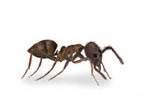
• Workers about 2mm long.
• Light to dark brown in colour.
• Do not swarm.
• Bite – do not sting.
Lifecycle
• Worker ants produced in Spring and increase in numbers up until autumn.
• Winged ants, (reproductive Kings and Queens), produced in early Spring, before the workers, mature within three months and mate soon afterwards.
• Argentine ants mate in their nest so no swarming is seen.
Habits
• Worker ants will follow food trails for long distances so nests are not easy to track.
• They prefer sweet foods but will also eat live and dead insects, meats, cereals and damaged fruit.
• Argentine ants drive out other ant species from an area.
Carpenter Ants
Camponotus pennsylvanicus
Appearance

• Workers - 1/4" long.
• Queen - 1/2" long.
• Blackish color most common but can also be black and red.
• 6 legs.
Lifecycle
• Swarms appear in the Spring.
• The colonies of carpenter ants can live from 3-6 years.
Habits
• Locations - both moist and dry wood, but prefer moist, eg wood dampened by water leaks.
• Internally - excavate galleries in wood with a smooth appearance.
• Externally - sometimes hollow out sections of trees.
• Visibility - hunt for food mainly at night but also during the day in early spring / summer. Signs include sawdust, wet wood, or unusual noises coming from the walls.
• Feeding - primary food is honeydew, also eat plant secretions, fruit juices and insect remains. They do not eat wood. In homes they are attracted to sweet substances, fats, grease and meats.
• Contact - rarely come into contact with people, but if they do will try to escape. They cannot sting.
Citronella Ant
Acanthomyops claviger
Appearance
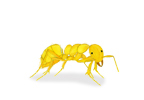
• Colour varies from light yellow to dark reddish-yellow or light brown.
• Workers 3/16" long.
• Swarmers 1/8" long.
• Single node to the pedicel.
• Sparse, erect hairs on the head, thorax, and abdomen.
Lifecycle
• Swarms arrive in the late Winter and Spring, often mistaken for termites.
Habits
• Odour - produce an agreeable citronella smell when crushed.
• Nesting – varies from open woods, pastures, gardens, lawns, next to house foundations. Colonies sometimes found beneath concrete slabs, large rocks, or rotting logs. Colonies have mounds of soil around the openings.
Fire Ant
Solenopsis spp
Appearance
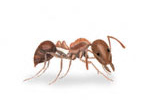
• Queens 15mm long.
• Workers 3–6mm long.
• Coppery–brown on the head and body, with a darker abdomen.
• Solenopsis has a very distinctive two–segment antennal club, which is most visible in the front view of the female reproductive ant.
Lifecycle
• After swarming from the nest and mating the queen searches for a suitable spot to lay her eggs. Once found, she can lay up to 125 eggs in late spring.
• Larvae hatch within 8 to 10 days, and the pupal stage lasts for 9 to 16 days.
• Larvae feed on secretions from the queen’s salivary glands and broken down wing muscles until the first worker ants emerge. After this first batch of larvae moult into workers the queen’s role returns to egg laying – she can lay up to 1500 per day. Worker ants continue with larval care, nest building and food foraging.
• Fertile males are produced later in the season.
Habits
• Foraging workers diet consists of dead animals, including insects, earthworms, and vertebrates. Workers also collect honeydew and forage for sweet food, proteins, and fats.
• Swarming characteristics – mating between queens and fertile males takes place on the wing mid to late summer. Males perish after mating.
• Nest locations can be a mound of up to 40 cm or next to objects found on the ground, e.g. logs.
• If aggravated, these react aggressively and can inflict a painful sting, resulting in a pustule some 48 hours later.
• These ants are a major agricultural and urban pest, destroying crops and invading residential areas both outdoors and indoors.
Black Ant or Garden Ant
Lasius niger
Appearance
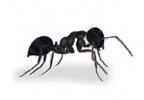
• Workers 4–5mm long.
• Queens 15mm long.
• Dark brown–black in colour.
• 1 small segment at waist point (pedicel).
• No sting present.
Lifecycle
• Queens overwinter in soil. Eggs are laid in late spring. Larvae hatch 3–4 weeks later.
• Larvae feed on secretions from the queen's salivary glands until the first worker ants emerge.
• Worker ants continue with larval care, nest building and food foraging.
• Fertile males are produced later in the season.
Habits
• Foraging worker ants follow well–defined trails around food sources. Sweet foods are preferred but high protein foods will also be taken.
• Swarming characteristics – mating between queens and fertile males takes place on the wing mid to late summer. Males perish after mating.
• Nest locations – often outdoors in soil and below paving slabs on the sunny side of buildings. Nest locations can be identified by the presence of finely powdered soil around nest exit holes.
Ghost Ant
Tapinoma melanocephalum
Appearance
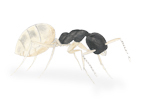
• Dark head.
• Pale / Translucent legs and abdomen.
• 1/16 inch long.
Lifecycle
• Continuous breeding colonies.
Habits
• Feeding – indoors: sweet substances and grease; outdoors: insects that produce honeydew.
• Nesting – indoors: small spaces, wall voids; outdoors: in flowerpots, under objects on the ground, under loose bark.
• Locations - attracted to high moisture areas, can be found in kitchen and bathroom cabinets.
• Colonies can occupy several different nesting sites.
Odorous House Ant
Tapinoma sessile
Appearance
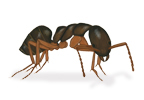
• Dark head.
• Pale / Translucent legs and abdomen.
• 1/16" long.
Lifecycle
• Continuous breeding colonies.
Habits
• Feeding – indoors: sweet substances and grease; outdoors: insects that produce honeydew.
• Nesting – indoors: small spaces, wall voids; outdoors: in flowerpots, under objects on the ground, under loose bark.
• Locations - attracted to high moisture areas, can be found in kitchen and bathroom cabinets.
• Colonies can occupy several different nesting sites.
Pavement Ant
Tetramorium caespitum
Appearance
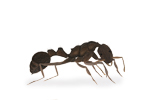
• Dark brown or blackish.
• 1/8" long.
• 6 legs.
• 2 spines on the back.
• 2 nodes on petiole.
• Grooves on head and thorax.
• Thorax uneven with 1 pair of spines.
• 12-segmented antennae with 3-segmented lub.
• Winged ants are often mistaken for termites.
Lifecycle
• Visible Spring and Summer.
• Have been known to emerge any time of the year in heated structures.
Habits
• Feeding - eat almost anything that humans eat, and also pet food.
• Visibility - seen entering houses looking for food, most often at night. May move through pipes and electrical wires.
• Nesting - in lawns or under stones, wood, or boards. Mounds built along sidewalks, baseboards, and near foundations in clusters. Colonies found near water.
Pharaoh's Ant
Monomorium pharaonis
Appearance

• Workers 1.5–2mm long, yellow–brown with brown abdomen.
• Males 3mm long, black and winged.
• Queens 3.5–6mm long, dark red in colour with wings.
• Black eyes. 2 small segments at the pedicel.
Lifecycle
• Multi–queen colonies.
• Swarming can take place at any time of the year.
• Winged adults seldom fly so rarely seen. Wings are soon lost after mating.
Habits
• Well–defined trails are laid which are often associated with heating systems. Feeds indoors on high protein foods — meat, fats, blood, dead insects, etc.
• Swarming characteristics — new colonies are often formed through nests that have been disturbed e.g., as a result of insecticide spray treatments. Each queen produces up to 3500 eggs in its lifetime.
• Nest locations — deep seated in cavities in heated buildings. Often found in hospitals. Associated with humid conditions. Colonies can range from a few dozen to 300,000 individuals.
Roger's Ant
Hypoponera punctatissima
Appearance
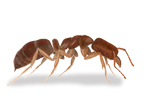
• Reddish brown in colour.
• Workers 2mm long.
• 1 large segment at the pedicel.
• 1st two segments of the abdomen are constricted.
• Sting present.
Lifecycle
• Little is known about the life cycle.
Habits
• Workers forage randomly and lay no trails as live prey are hunted, especially springtails. Rarely seen outdoors.
• Swarming characteristics — will swarm all year round. Winged adults are often found in electric fly killers.
• Nest locations — damp residues and debris. Crevices around drains and behind broken wall tiles.


